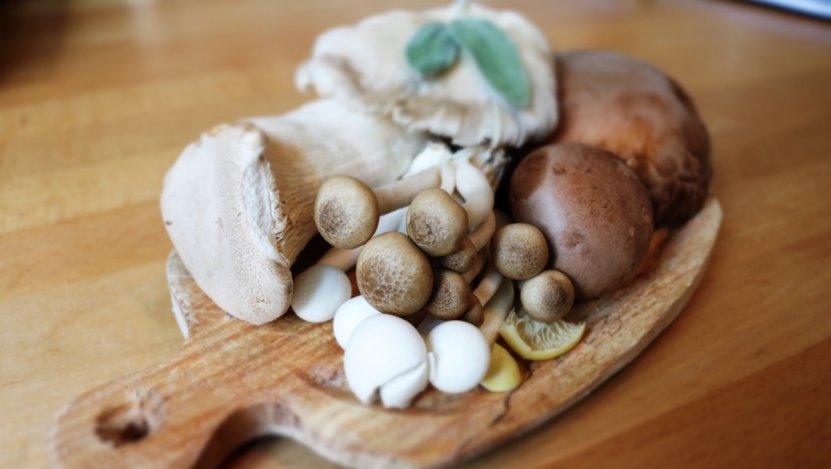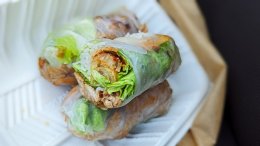I must preface this guide by saying that I am mushroom obsessed. I find any excuse I can to cook them, and I put them in virtually anything. That being said, 90 per cent of Canada’s cultivated mushroom crop is made up of white button and brown (cremini and portabello) mushrooms. Frankly, I find them a little less interesting than the remaining 10 per cent of cultivated mushrooms, and the plethora of wild mushrooms out there waiting to be eaten. So Let’s get our shroom on and start incorporating more mushroom into your diet.
Enoki (cultivated)
These long, slender white mushrooms are a staple in East Asian cuisine. They are typically used in soups, which is an easy application because they will cook almost instantaneously when dropped in hot broth. You can also make faux “pulled pork” by cooking them down and tossing them with barbecue sauce. Are you wondering why they are so pristinely white? Similar to white asparagus, they are grown in the dark and this lack of exposure to light prevents colour pigments from developing.
King oyster (cultivated)
The pleurotus eryngii, or king oyster mushroom as it is more commonly called, is native to the Mediterranean in its wild form. In Canada, it is cultivated and can be recognized by its thick white stem and light brown cap. King oysters are especially durable and will remain fresh for over a week if stored properly (refrigerated in a paper bag). They keep their texture when cooked, so they are well suited to searing or grilling and being served as “mushroom steaks.” Simply halve them and score the flesh in a cross-hatched pattern, sear them in a neutral-flavoured oil until they develop a nice colour, and finish them with flavoured salt of your choice. Truffle salt, anyone?
Oyster (cultivated)
Oyster mushrooms are definitely one of the more delicate varieties of mushrooms out there. They’re almost velvety to touch and come in a variety of colours, from pink to blue. Interestingly, they were first cultivated in Germany to help provide sustenance during World War II. Nowadays, their use extends far beyond that. At their most basic, they can be tossed into stir fries, but you can also use them to jazz up mushroom omelettes, mushroom pastas, or mushroom salads. Even simply roasted or sautéed with salt and pepper, they are still delicious!
Shiitake (culivated)
Shiitakes have a characteristic thin stem and wide but thin brown cap. They can be found fresh or dried and can be used in a variety of applications. For thousands of years, they have been prized in Chinese medicine for their health-promoting qualities and Western researchers are starting to catch on. Lately, research is being done on their anti-atherosclerotic properties, their potential to protect against cardiovascular diseases. Health benefits aside, they taste good and can add a boost of umami to just about anything! Just be sure to remove the stems, which can be reserved for making stock, as they are relatively tough.
Black trumpet (wild)
Known as “trompette de la mort,” or cheerily, “trumpet of death” in French, black trumpet mushrooms are thought to have gotten their name because they were viewed as trumpets being played by dead people under the ground. They are meaty and rich, and all of their uneven edges curl up and crisp when cooked. Black trumpets grow under broad-leaved trees like beech and oak, and can be found in B.C. as well as Ontario.
Chanterelle (wild)
Chanterelles grow in a surprisingly large number of areas in Canada, including British Columbia, Ontario, Quebec, the Maritimes, and even Saskatchewan. Also known as “girolle” in French, they are bright orangey-yellow in colour and tend to grow around the mossy bases of coniferous trees. If you’re foraging for them yourself, be on the lookout for false chanterelles, which aren’t poisonous but don’t taste as good as the real thing and may cause some gastrointestinal problems. Because many of the flavour compounds in chanterelles are fat-soluble, cooking them in butter is the way to go. Keep it simple, and don’t mess with this delicacy!
Lobster (wild)
One look at a lobster mushroom and it is easy to see how they got their name. Because they are the same bright orange-red colour as cooked lobster and no other mushrooms look remotely like them, novice foragers can be on the lookout for them easily. They don’t have gills, nor do they have a distinct stem or cap. Instead, they are more of a giant fan of edible mushroom. They can be found during September and October under trees such as hemlocks, most commonly in B.C. and Ontario.
Maitake a.k.a. Hen-of-the-woods (wild)
One of my favourite wild mushrooms. There’s nothing I like more than a sizeable piece of braised maitake mushroom. Maitake actually means “dancing mushroom” in Japanese. It’s an appropriate name because these mushrooms make me do a little happy dance. They’re a polypore mushroom, meaning that they grow in clusters. You don’t have to add a lot of flavours because they are naturally meaty and woodsy all on their own. Like shiitake, they have also shown promising health benefits, like potentially boosting the immune systems of those with cancer. They can be found in parts of Eastern Canada.
Matsutake (wild)
Matsutakes have a single, thick stem that almost blends into the upper cap. They are white in colour. Also known as pine mushrooms, they tend to grow under pine trees, and can be found in parts of British Columbia. They are prized in Japan for their unique, almost spicy, aroma and are actually given as gifts to celebrate fall.
Morel (wild)
Probably the most prized wild fungi other than truffles, morels are harvested in spring rather than fall, and look like little conical sponges. There are actually several species of morels, some of which are edible and some of which are not. Beefsteak morels typically come up before edible ones and are very toxic. As for the ones you can eat, because they grow in sandy areas, they should be washed thoroughly before cooking to avoid any grit. They are great paired with sweet peas and are best left whole. B.C. is your best bet for finding them, but you have to get through winter first!
Porcini (wild)
Last but not least is the boletus edulis, otherwise known as the porcini or cep mushroom. Apparently, some also call it the “Penny Bun” mushroom, although that was news to me. I suppose the name makes sense given its round, rusty brown, almost copper cap. It is widely used in Italian cuisine in both its fresh and dried forms. Porcini risotto is nothing new, but it’s a classic way of showcasing the earthy richness that these mushrooms lend. You can also find porcini powder, which is great added to dry rubs, dredges, and even savoury custards.













